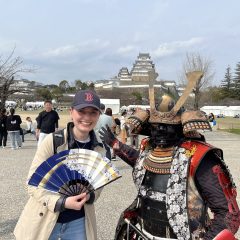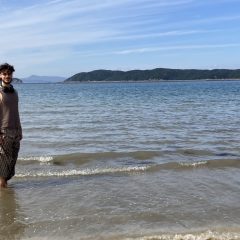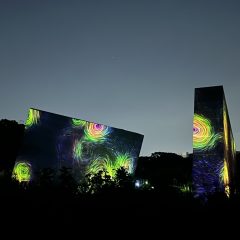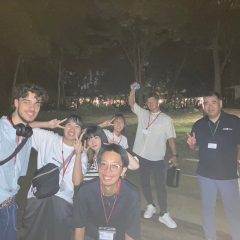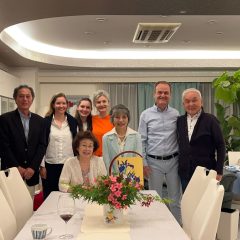☆☆☆third report of Felicitas Künlen , 23rd scholarship holder of the GRÜNWALD foundation☆☆☆
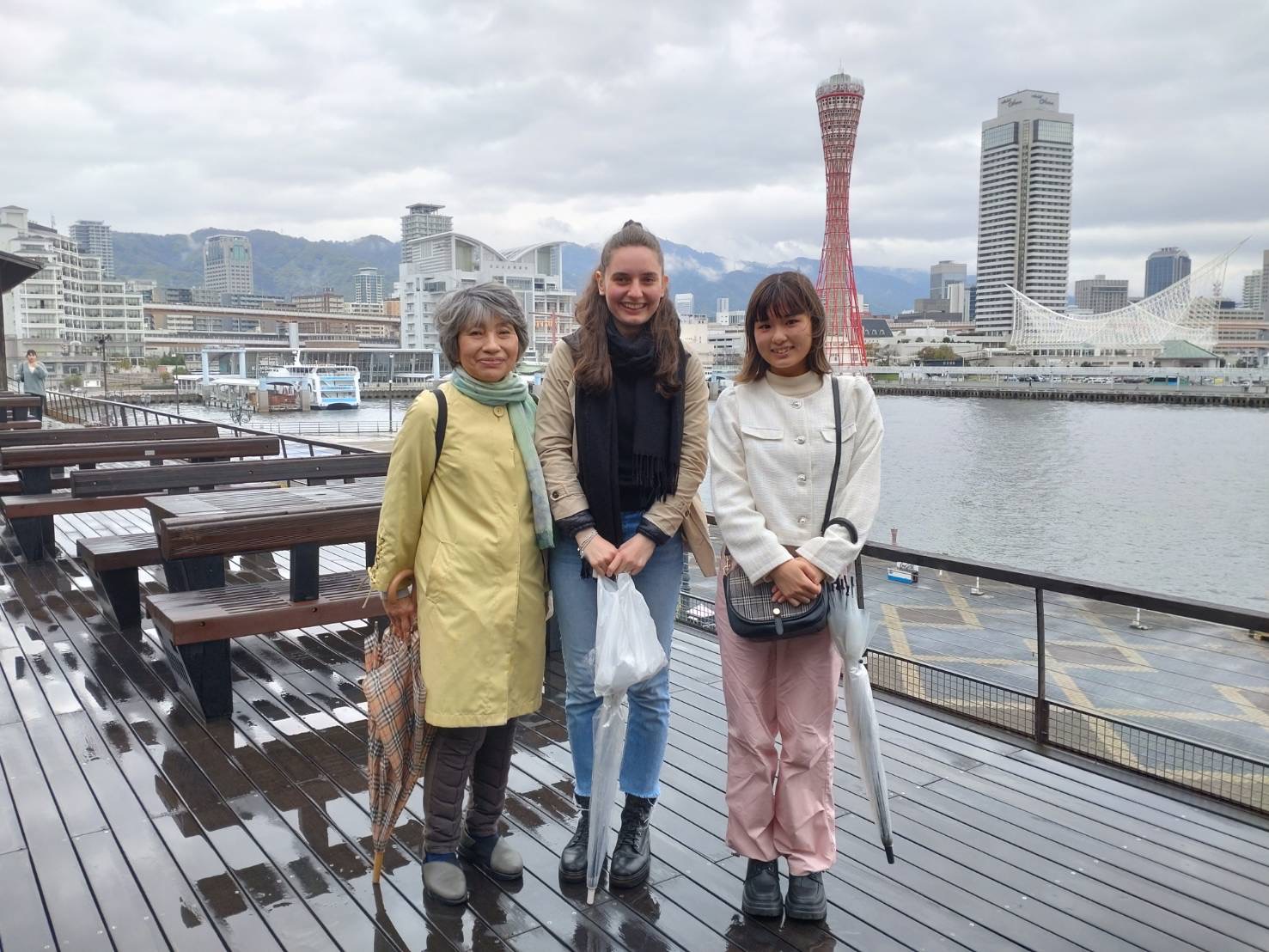
It’s the beginning of April and with it the cherry blossom. At last! The whole of Japan is turning upside down because of the delicate pink petals that are now appearing on the trees. The weather is slowly getting warmer, but it’s raining a lot. April seems to be doing what it wants here too. As I don’t have any more compulsory appointments, I have plenty of free time to explore Osaka and its surroundings. I came across the Nakazakicho neighbourhood purely by chance when I wanted to escape the hustle and bustle of the streets of Umeda. At first glance, it seemed like a quiet residential neighbourhood, but the deeper I delved into the alleyways, the clearer the unique character of this area became compared to other parts of Osaka: it is a green oasis between the skyscrapers and modern buildings that takes you back to the Showa era (1926-1989) with its winding streets and clotheslines strung between the houses. It’s a tranquil neighbourhood with charming cafés, art galleries and boutiques selling handmade treasures. Signs reading ‘NO PICTURE’ can be seen outside many of the establishments.

Nakazakicho’ with its small cafés and pretty shops
Apparently, people like to use the neighbourhood as a backdrop for a new Instagram photo. I let myself drift and suddenly find myself in one of the red gondolas of the Ferris wheel on the roof of the shopping mall ‘HEP 5’. The shopping centre is known far beyond Osaka’s city limits for this attraction. So I decide to take a look at Osaka from above. 3 euros later, however, I quickly realise that the concept is designed more for couples in love: Bluetooth speakers in the gondola let you listen to romantic songs while you can see Osaka Castle in the distance. Unfortunately, the box doesn’t connect, otherwise a round of German hip-hop would have helped me combat the lonely feeling of sitting alone in a gondola. For my part, I’m glad to have solid ground under my feet again. Because in the end, the view wasn’t that impressive after all…

The red Ferris wheel on the roof of ‘HEP 5’
On 3 April, Nobuko Ikawa gives me an exclusive and excellent guided tour of the city of Kobe. The weather is cold and rainy, but the atmosphere is warm and welcoming. The tour begins with a visit to Kobe City Hall, including a great view of the harbour where the container ships come in. The monument in Memorial Park, which commemorates the 1995 earthquake, can also be seen from above. In the lift, I have to fend off a marriage proposal from a Japanese man in his mid-80s who has fallen in love with my blue eyes.
During the Meiji period (1868-1912), Japan increasingly opened up to international trade: Kobe became one of the most important harbours for the exchange of goods with the West and a transshipment point for trade with Europe. European merchants, diplomats and missionaries settled in the city, and with them came Western influences in areas such as cuisine, fashion and culture. Another historical moment that reinforced the European influences in Kobe was the establishment of a foreigner district towards the end of the 19th century, also known as ‘Kitano-cho’. Even the architecture reflects European styles. For example, you can still admire a weathercock perched on the roof of a house.
Finally, Mrs Ikawa gives me a sake and a small sake cup as a present and I return home feeling fulfilled after this wonderful day.

Visit to the city of Kobe with Mrs Ikawa and the student Kasumi
The following day, 04 April, I treated myself to a cosmetic/acupuncture treatment. The beautician is – in typical Japanese fashion – very well prepared: A small translation device translates everything into English for me in a robotic voice. It is interesting to see how beauty is viewed in Japan and how it can be achieved: Whereas in Europe the focus is on external applications, in Japan the approach is ‘beauty comes from within’. At the beginning, I am given intestinal bacteria to drink and my neck circumference is measured. The treatment ultimately consists of a combination of lymphatic drainage, acupuncture, acupressure and skin treatment. Around 70 minutes later, I am as radiant as a peach and my neck circumference is 5 millimetres smaller.
Well rested and still radiant, I then go to my first Japanese lesson on Friday 5 April. Whether I am a natural at this, as I am at pottery, is debatable. At least I can now count from 1 to 10 fluently!
And the weekend is also exciting: Oka invites the residents of Grünwald, including me, to Ohanami, the cherry blossom festival! There is plenty of alcohol and delicious food. I (guest of honour:) sit in the middle of it all – surrounded by the friendly and interested household. My neighbours are astonished when they find out that I come from the ‘original’ Grünwald. I was also amazed when I learnt that pupils who attend a public school also have to go to school on Saturdays. I’d rather not be in one of those…

Ohanami in the Japanese Grünwald
On Sunday, I go on a boat trip on the Yodo River with my new Japanese friend Kako to admire the almost fading cherry blossom one last time. We are early, which proves to be a good idea. Countless Japanese people have the same idea and also want to admire the pink blossom splendour from the boat. Unfortunately, we are sitting on the wrong side (right would have been better) and so I have to admire the cherry blossoms while a Japanese sun hat (surely with sun protection factor 50) blocks my view.

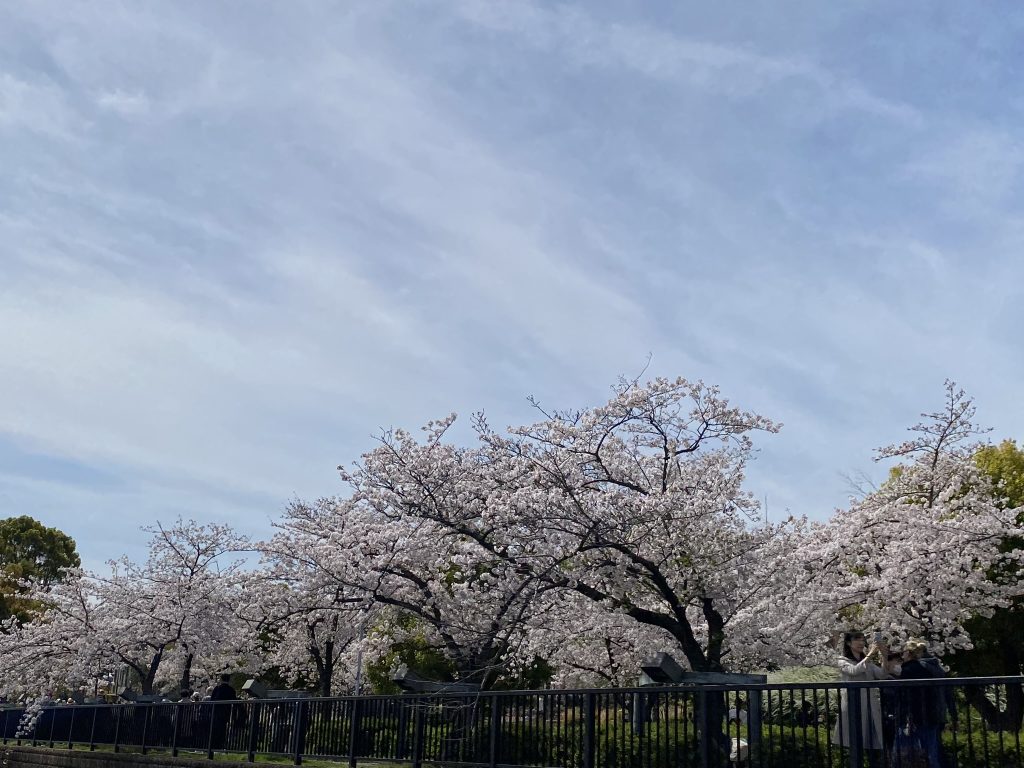
Boat trip with my new friend Kako
After sakura comes water lily – and so I admire Claude Monet’s water lilies in oil on canvas at the Nakanoshima Museum of Art. The exhibition in Osa-ka runs until the end of May 2024, so many people want to see his works. The exhibition rooms are already packed in the morning, with staff holding signs warning visitors not to speak too loudly. In typical Japanese fashion, the queue of people pushes past the paintings. Walk around freely? Very few people do. To see the pictures, you either have to join the queue – or simply stand in the second row. Thanks to my fortunately relatively tall height (or are the others just shorter than me?), I can look over the Japanese heads and admire the European landscapes. ‘Strange, standing in Japan and looking at French haystacks,’ I think to myself. In keeping with the French theme, I have crêpes with salmon afterwards.
As the last few weeks have been spent eating and drinking alcoholic beverages, I decide that a bit of exercise wouldn’t do me any harm. So I set off on an ‘Osaka Guided City Highlights Bike Tour’: on Thursday morning, three Swiss nationals and I cycle after our muscular Japanese tour guide, who also works as a fitness trainer and barista. According to him, his favourite food is cheese – so we quickly found a topic of conversation with the Swiss. They are not necessarily known for their sense of humour – my joke that the climb up Osaka Castle was reminiscent of a climb in the Swiss Alps was nevertheless met with general amusement. The cycle tour was very nice per se, but unfortunately not quite as effective: I had already ‘shown’ all the sights to myself!

Cycle tour through Osaka
After a private Pilates lesson, where I didn’t understand all the instructions from the English-speaking teacher (I’m apparently not a natural at Pilates), I take a stroll through America-Mura (again…): I simply love the informal atmosphere of the neighbourhood, partly because there’s always something going on there. I strike up a conversation with a German couple in a coffee shop. It turns out that they both live in Berlin, but their parents live in Baierbrunn, 15 minutes away from where I live… small world.
I’m going to Tokyo for the weekend (20 to 22 April). Saturday morning, the Shinkan-sen thunders westwards at 320 km/h. This time Tokyo wants to show itself from its best side, because I am greeted with the best weather and sunshine. It’s always fun to see: In Tokyo, people stand on the escalator on the left, in Osaka on the right. I have to remind myself once again that Tokyo is a huge city: 13.96 million people (as of 2021) live here! But ‘the place works’, as the saying goes. There is no rubbish lying around, the trains arrive on time, the traffic is humane and the air is good. Tokyo is considered a model city all over the world. This has been achieved above all through clear social structures and a functioning transport network: with around 3.1 billion passengers a year, the Tokyo underground is the most heavily used public transport system in the world.
The 13 lines of the Tokyo underground are used by an average of 8.5 million people every day. Delays of even one minute are announced, markings on the floor indicate where to stand to board, and birdsong on the platforms creates a peaceful atmosphere. And the job is carried out according to the ‘kaizen’ principle, the Japanese aspiration to always and constantly improve. This ensures conscientiousness at work.
On Saturday evening, I go on a bike tour under the motto ‘Tokyo by night’ together with a somewhat grumpy-looking KLM crew that has a 49-hour stopover in Tokyo. But maybe the flight attendants were just overworked and tired, who knows. The friendly tour guide Taichi may not have as strong calves, but he has all the more knowledge and so we cycle from 8pm to 10.30pm through the ‘Aoyama Area’ and to the ‘Roppongi Hills’ before turning round at the red Tokyo Tower and cycling past the National Stadium back towards the starting point. Tokyo’s skyline glistens promisingly in the dark night and I can’t stop marvelling at all the lights and lamps. Then I take the train for an hour back to my hotel in Kawasaki and fall asleep at midnight, dead tired.
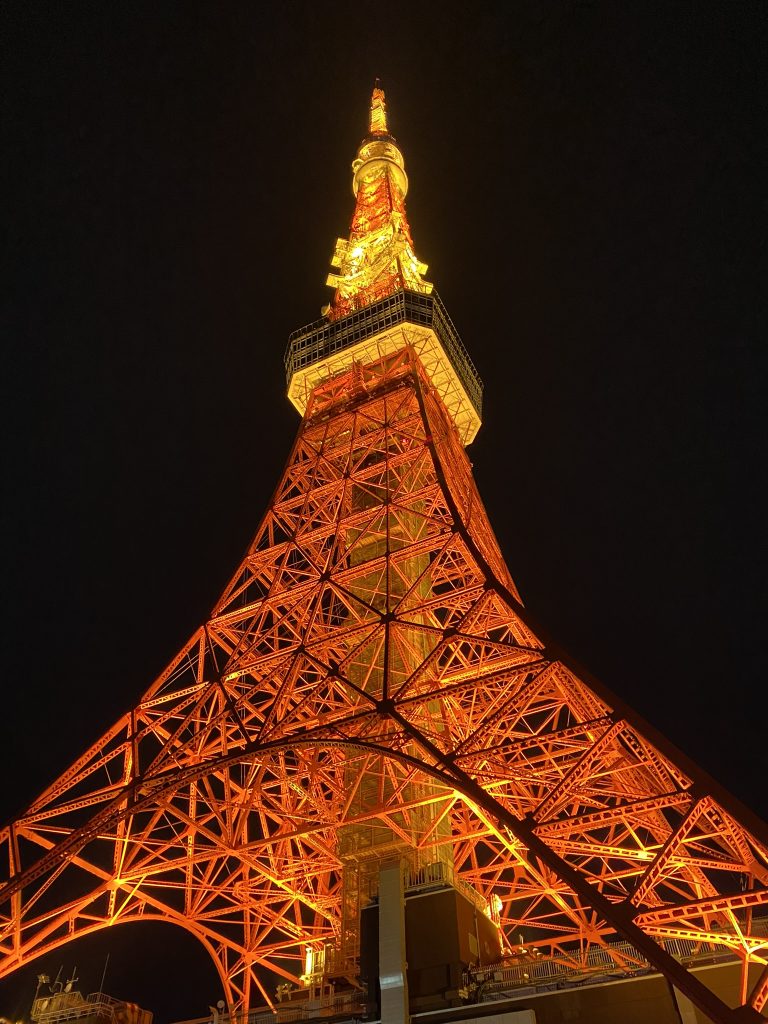
The red Tokyo Tower
Sunday 14 April – it should be a wonderful day! In the morning I have brunch in a restaurant, which saves me lunch – very practical. I strike up a conversation with the friendly waiter Rob, a Dutchman about my age who has lived in Tokyo for three years. ‘You live for work,’ he says, he has no Japanese friends, it’s hard to socialise. Then I drive on to ‘Harajuku’, known for Japanese hipsters and ‘kawaii fashion’. I take a closer look at the latter in a shop with the interesting name ‘6 % Doki Doki’.
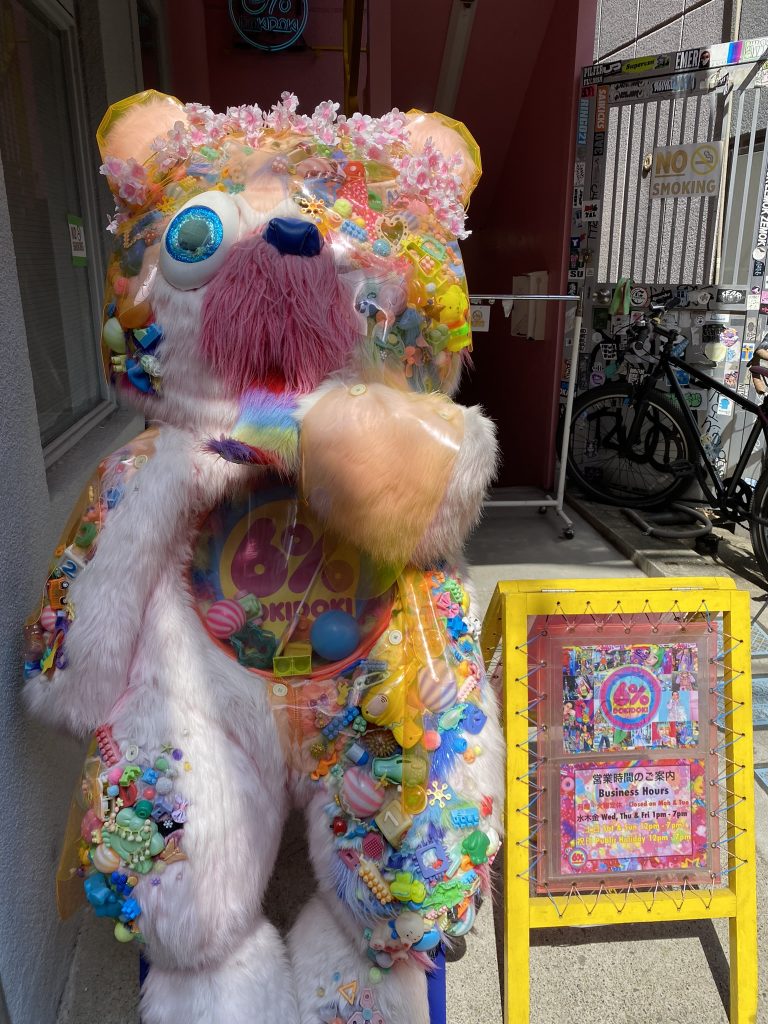
Decoration in front of the shop 6% Doki-Doki. The shop is similarly colourful.
Crazy is not an expression… a shop assistant with a pink plaster on her nose – she wears it for style reasons – and purple hair greets me. She’s doing a tik-tok in the entrance and looks delighted when I walk in. I don’t think there are many foreigners in the small shop on the first floor and look around with interest.
Both I and the two shop assistants realise that I won’t be buying anything there and that I won’t find anything that would look good on me. Despite everything, they keep clapping their hands and smiling at me in a friendly manner. When I point to their colourful outfits and say ‘Wow’ out loud, they are so delighted with me that they giggle out loud and are so happy that one of them even drops the silver glitter hair clip from their head. In the neighbourhood itself, however, there are completely different ‘characters’ walking around. Yes, the young people there really like it fancy: I come across a girl whose styling model is apparently the Virgin Mary. There’s no other explanation for the scaffolding on her head, which is supposed to imitate a halo. And there are clothes hanging in the shops that I can only guess what they are for.
At 6 pm, I have a reservation at the Tokyo Skytree, the 634 metre high television and radio broadcasting tower. It was opened on 22 May 2012 and is the third tallest building in the world after the Burj Khalifa in Dubai and the PNB 118 in Kuala Lumpur. Built to withstand earthquakes, the steel colossus gleams in the evening light. My plan was actually to be up there in time for sunset. However, I’m just as punctual that I don’t make it and the sun has just set… because the many tourists delayed the lift ride to the top. While waiting in the queue at the bottom, I ‘make friends’ with three middle-aged German women who are actually from a tour group and have a free evening at their disposal. I am allowed to join them and we float up together. It’s also nice not to have to admire the view up there alone, without conversation…
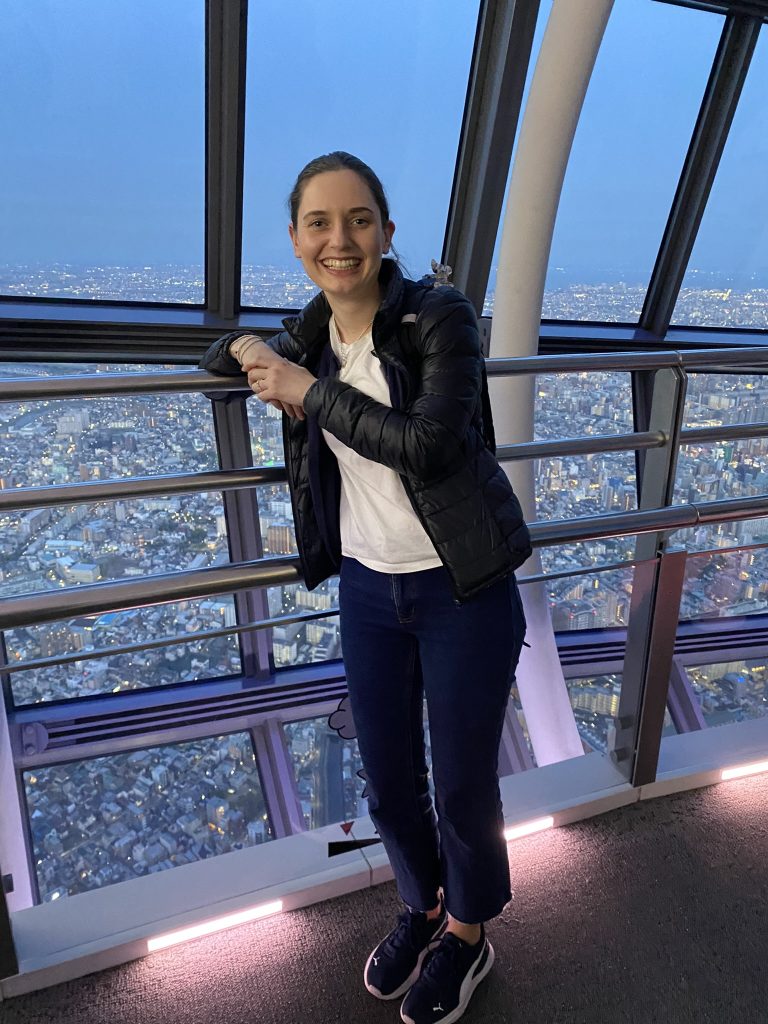
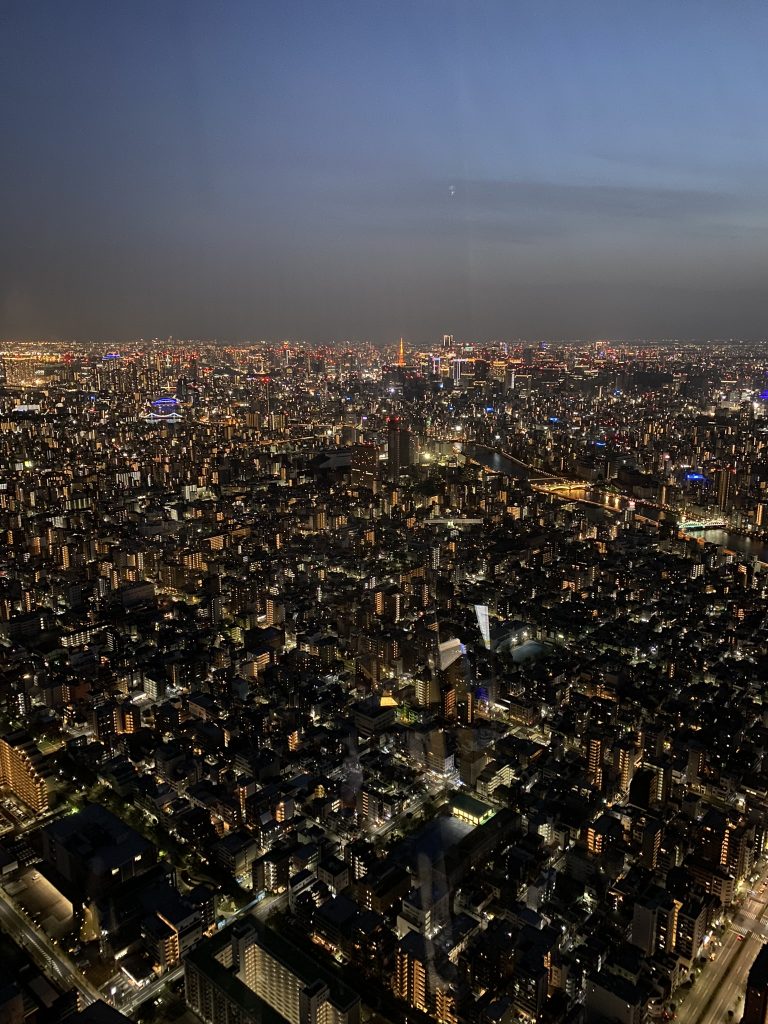
View from Tokyo Skytree
After a fulfilling weekend, I lock my suitcase in a locker at Tokyo Central Station on Monday morning and head to Kababashi Street – a shopping street specialising in restaurant and kitchen supplies with over 200 shops. A typical Asian speciality is the sale of plastic replicas of dishes and drinks, which are mainly used by small restaurants to advertise in their shop windows. I find it hard to decide between a prawn and an ice-cream sundae as a new room decoration. In the end, it’s the sundae and, for reasons of love of my homeland, the beer from ‘Der Löwenbräu’.


Plastic food-typically Japanese
Then it’s on to ‘Akihabara Street’, which is advertised to me as a paradise for electronics, technology, manga and anime. I’m actually in the wrong place there, because I don’t need a new kit for my robot (you can buy one there), nor do I know a single manga or anime character (apart from Hello Kitty). Nevertheless, the neighbourhood between the many skyscrapers is a kind of ‘must-see’ on the to-do list of every Tokyo tourist. To see something cultural in between, I walk to the ‘Kanda Myōjin Shrine’ away from the neighbourhood. Employees of the countless tech companies go there because the temple promises good performance and new ideas/inspiration for those praying. I sit quietly and observe the people in peace. The individual leaves of the cherry blossoms gently fall down on me – sakura is over. Japanese music plays softly in the background. There is also a small horse on the temple grounds – it has its stable to the left of the shrine. In front of it: many Japa people who, it seems to me, have never seen a pony before. They watch the four-legged creature eat, fascinated and enraptured in equal measure.

Horse in front of the Kanda Myōjin Shrine
An elderly lady in a kimono gets off the Osaka-bound Shinkansen in front of me. A pink silk scarf rests on her shoulders, which promptly falls into the gap between the train and the platform. She doesn’t realise she’s lost it and carries on walking. I tap her on the shoulder and say ‘sumimasen’ (sorry) in my best Japanese. Then I try to explain to her in sign language that her scarf is in the track bed. A Japanese man comes to my aid and tells her – lucky for me, I wouldn’t have known what track bed means in Japanese. The lady then turns to me full of gratitude and thanks me in the little English she knew: ‘Thank you very much’.
Was this deed credited to my karma points account? Maybe, because on the return journey I am rewarded with a cloudless Mount Fuji! I also leave Tokyo feeling less stressed this time. I think the secret lies in the fact that, like the people of Tokyo, you have to let yourself drift with the crowds in a more relaxed way and get more involved with them. And, if necessary, to afford a taxi if the GPS signal can’t locate you because of all the tower blocks and you’ve been walking in the wrong direction for minutes…
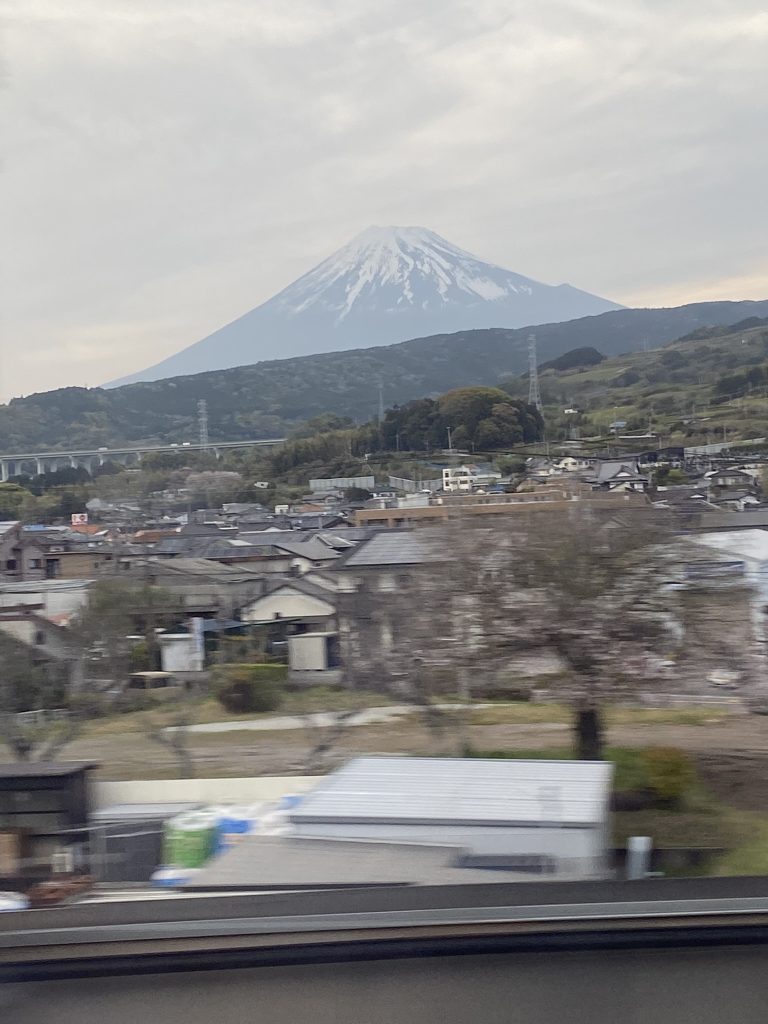
Mount Fuji in the evening light

